-
 Bitcoin
Bitcoin $106,782.3966
-0.72% -
 Ethereum
Ethereum $2,406.7764
-1.16% -
 Tether USDt
Tether USDt $1.0005
0.02% -
 XRP
XRP $2.0918
-1.53% -
 BNB
BNB $644.5785
-0.17% -
 Solana
Solana $141.0925
-0.69% -
 USDC
USDC $1.0000
0.02% -
 TRON
TRON $0.2721
0.18% -
 Dogecoin
Dogecoin $0.1585
-1.26% -
 Cardano
Cardano $0.5497
-1.14% -
 Hyperliquid
Hyperliquid $35.8493
-1.58% -
 Bitcoin Cash
Bitcoin Cash $502.3089
2.20% -
 Sui
Sui $2.7092
3.87% -
 Chainlink
Chainlink $12.8551
-1.85% -
 UNUS SED LEO
UNUS SED LEO $9.0548
0.53% -
 Stellar
Stellar $0.2344
-0.85% -
 Avalanche
Avalanche $17.2676
-0.23% -
 Toncoin
Toncoin $2.8282
0.56% -
 Shiba Inu
Shiba Inu $0.0...01113
-1.14% -
 Litecoin
Litecoin $83.9593
-0.93% -
 Hedera
Hedera $0.1447
0.82% -
 Monero
Monero $306.9022
-2.07% -
 Bitget Token
Bitget Token $4.6358
3.42% -
 Dai
Dai $0.9999
0.01% -
 Ethena USDe
Ethena USDe $1.0001
0.02% -
 Polkadot
Polkadot $3.3211
0.06% -
 Uniswap
Uniswap $6.8775
0.75% -
 Pi
Pi $0.5664
-0.27% -
 Aave
Aave $256.0055
1.28% -
 Pepe
Pepe $0.0...09013
-3.24%
Is it credible that the MACD golden cross but the trading volume continues to be lower than the 20-day moving average?
A MACD golden cross suggests bullish momentum, but low volume may indicate weak buying pressure and potential market manipulation.
Jun 27, 2025 at 11:14 pm
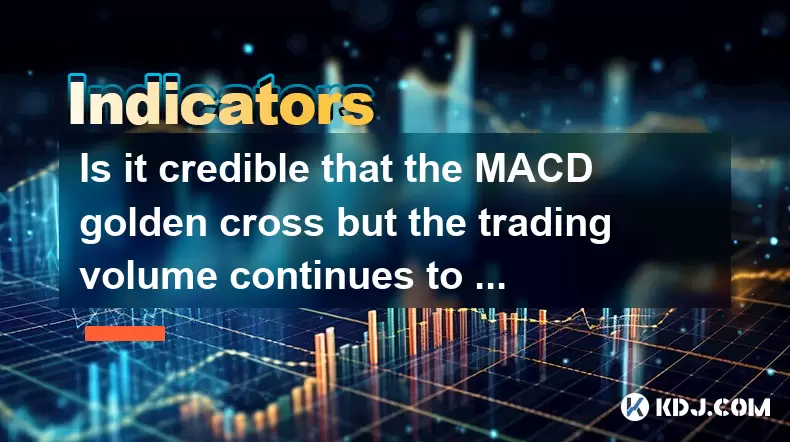
Understanding the MACD Golden Cross in Technical Analysis
The MACD golden cross is a commonly observed technical indicator in cryptocurrency trading. It occurs when the 12-day exponential moving average (EMA) crosses above the 26-day EMA, which is part of the Moving Average Convergence Divergence (MACD) line. This crossover is generally seen as a bullish signal, suggesting that upward momentum may be building.
In the context of cryptocurrencies, where volatility and rapid price movements are common, the MACD golden cross can appear frequently across various timeframes. Traders often interpret this pattern as an opportunity to enter long positions or exit short ones. However, it's crucial to consider other indicators alongside MACD to confirm the strength of the signal.
Important: The MACD golden cross does not guarantee a successful trade. It should always be used in conjunction with other tools for confirmation.
The Role of Trading Volume in Confirming Price Trends
Trading volume plays a vital role in validating the authenticity of any technical signal. When a golden cross appears, traders typically expect to see an increase in volume, indicating strong participation from buyers. A surge in volume during such events suggests genuine market interest and reinforces the likelihood of a sustainable uptrend.
However, if the volume remains below its 20-day moving average, it raises concerns about the strength of the rally. Low volume could imply that the move is being driven by a small number of participants or even algorithmic bots rather than broad-based buying pressure. In crypto markets, where manipulation and fake volume are persistent issues, this discrepancy becomes even more significant.
Key Insight: Consistently low volume relative to its moving average may indicate weak conviction behind the price movement.
Interpreting Discrepancies Between MACD and Volume
When the MACD generates a golden cross but volume fails to rise above its 20-day moving average, traders face a dilemma. On one hand, the MACD suggests bullish momentum; on the other, volume signals lackluster support for the price action.
This divergence can occur for several reasons:
- Market manipulation: Whales or bots might push prices higher without real demand.
- Short-term pump scenarios: Temporary rallies with no underlying support.
- Bearish continuation traps: The market might be setting up for another leg down after a brief bounce.
In such situations, relying solely on MACD can lead to false positives. It’s essential to incorporate additional metrics like on-chain data, order book depth, or volume profile analysis to better assess whether the move has legitimacy.
Critical Consideration: Always investigate why volume isn’t supporting the price movement before taking a position.
How to Analyze Cryptocurrency Charts for Such Signals
To effectively evaluate whether a MACD golden cross is credible despite weak volume, follow these steps:
- Plot the MACD and volume indicators on your charting platform (such as TradingView or Binance's native tools).
- Identify the exact point where the MACD line crosses above the signal line to confirm the golden cross.
- Compare current volume levels to the 20-day moving average of volume. This can usually be toggled on automatically within most platforms.
- Zoom out to higher timeframes (like 4-hour or daily charts) to get a broader perspective.
- Cross-reference with price action—is the candlestick formation showing strength or hesitation?
By systematically going through each step, traders can avoid impulsive decisions and gain clarity on whether the market is truly shifting in a bullish direction.
Pro Tip: Use multiple timeframes to validate signals and reduce false readings.
Case Study: Real-Life Example in Crypto Markets
Take the example of Ethereum (ETH) in early 2023. There was a period where ETH displayed a MACD golden cross on the daily chart, yet the volume remained below its 20-day moving average for several days afterward.
Traders who entered based solely on the MACD signal faced sideways movement and eventual pullback. Those who waited for volume confirmation either avoided losses or entered at better levels later. This case illustrates how misleading a single indicator can be without proper validation.
Lesson Learned: Relying on a single indicator without confirming volume can result in poor trade outcomes.
FAQs
Q: Can I still trade a MACD golden cross if volume is low?
A: Yes, but with caution. You should implement tighter stop-losses and smaller position sizes until volume picks up.
Q: What other indicators work well with MACD and volume?
A: Consider using Relative Strength Index (RSI), Bollinger Bands, or On-Balance Volume (OBV) to corroborate signals.
Q: How do I calculate the 20-day moving average of volume?
A: Add up the volume for the last 20 days and divide by 20. Most charting platforms offer this as a built-in feature.
Q: Is it possible for volume to be manipulated in crypto markets?
A: Unfortunately, yes. Many exchanges report inflated volumes. Always check volume against reliable sources or use on-chain volume metrics where available.
Disclaimer:info@kdj.com
The information provided is not trading advice. kdj.com does not assume any responsibility for any investments made based on the information provided in this article. Cryptocurrencies are highly volatile and it is highly recommended that you invest with caution after thorough research!
If you believe that the content used on this website infringes your copyright, please contact us immediately (info@kdj.com) and we will delete it promptly.
- Sonic, Magic Gathering, and July 2025: What's Trending?
- 2025-06-28 02:30:12
- Bitcoin Whale Inflows Nosedive: Are Investors Eyeing a New All-Time High?
- 2025-06-28 02:30:12
- Smart Investors Eye Audited Token RUVI for Rally Prediction
- 2025-06-28 02:35:12
- Mint, Childhood Memories, and Taste Experience: A Nostalgic Bite of the Good Old Days
- 2025-06-28 03:50:11
- Neo Pepe, XRP & Cardano: A Memecoin Summer Showdown?
- 2025-06-28 02:55:12
- Bitcoin ETFs, Institutional Demand, and S&P Global: What's the Hype?
- 2025-06-28 03:55:12
Related knowledge
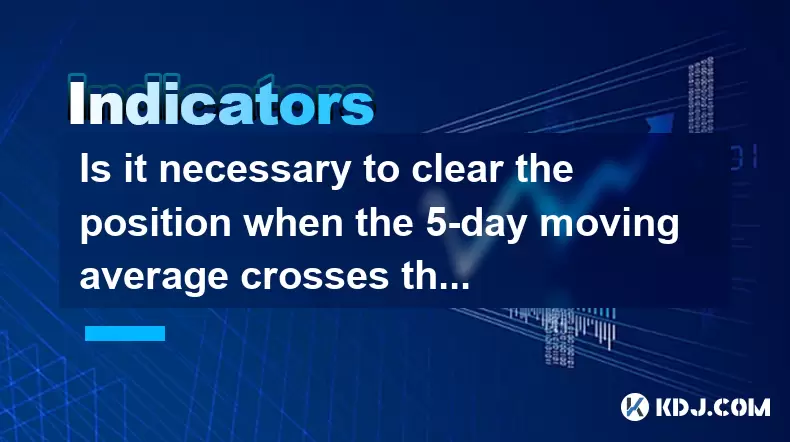
Is it necessary to clear the position when the 5-day moving average crosses the 10-day moving average?
Jun 27,2025 at 07:21pm
Understanding the 5-Day and 10-Day Moving AveragesIn the realm of technical analysis within the cryptocurrency market, moving averages play a crucial role in identifying trends and potential reversal points. The 5-day moving average (MA) and 10-day moving average are two of the most commonly used short-term indicators by traders. These tools smooth out ...
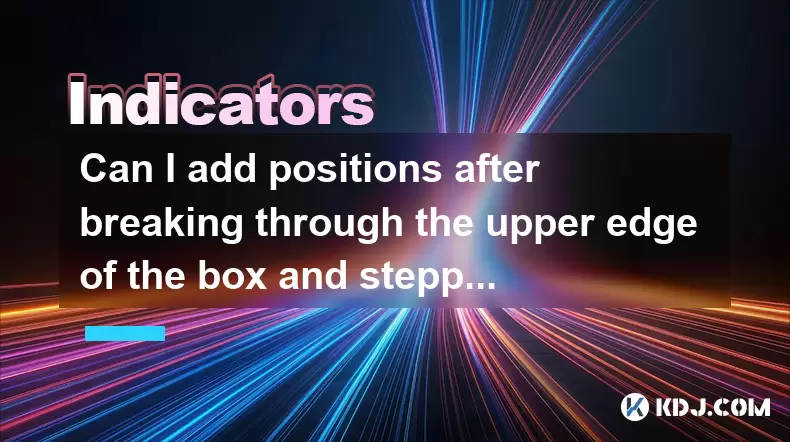
Can I add positions after breaking through the upper edge of the box and stepping back without breaking?
Jun 27,2025 at 09:56pm
Understanding the Box Breakout StrategyIn cryptocurrency trading, box breakout strategies are commonly used by technical analysts to identify potential price movements. A box, or a trading range, refers to a period where the price of an asset moves within two horizontal levels — the support (lower boundary) and resistance (upper boundary). When the pric...
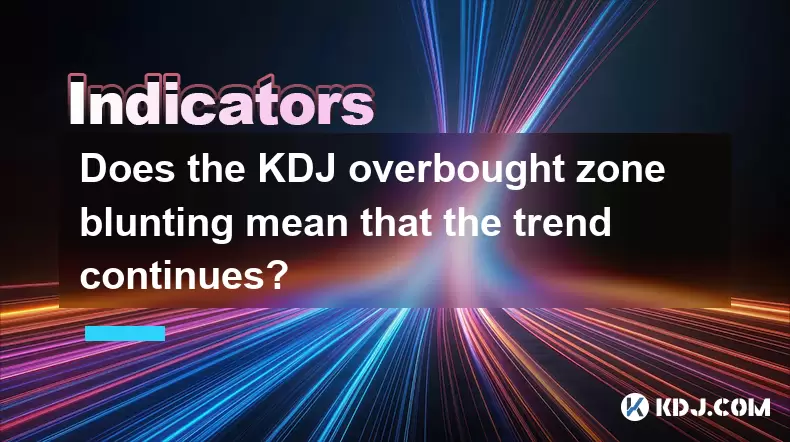
Does the KDJ overbought zone blunting mean that the trend continues?
Jun 27,2025 at 03:35pm
Understanding the KDJ Indicator in Cryptocurrency TradingThe KDJ indicator, also known as the stochastic oscillator, is a popular technical analysis tool used by traders to identify overbought or oversold conditions in asset prices. In the cryptocurrency market, where volatility is high and trends can change rapidly, understanding how to interpret the K...
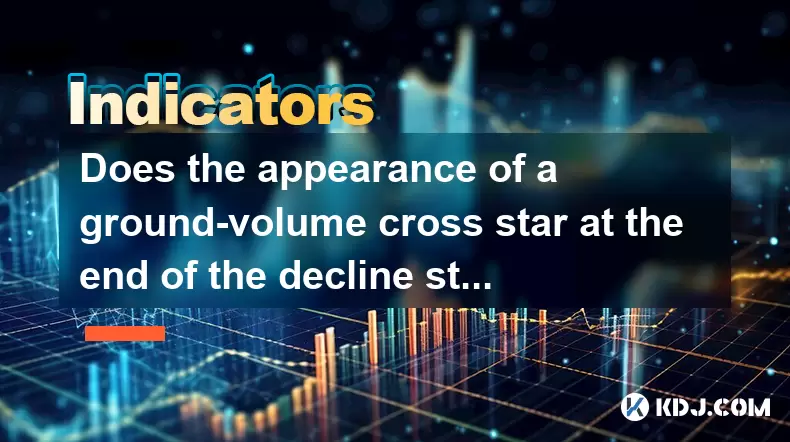
Does the appearance of a ground-volume cross star at the end of the decline stop the decline?
Jun 27,2025 at 10:35pm
Understanding the Ground-Volume Cross Star PatternIn technical analysis, candlestick patterns play a crucial role in identifying potential market reversals. One such pattern is the ground-volume cross star. This pattern typically appears at the bottom of a downtrend and is characterized by a small-bodied candle with long upper and lower shadows, accompa...
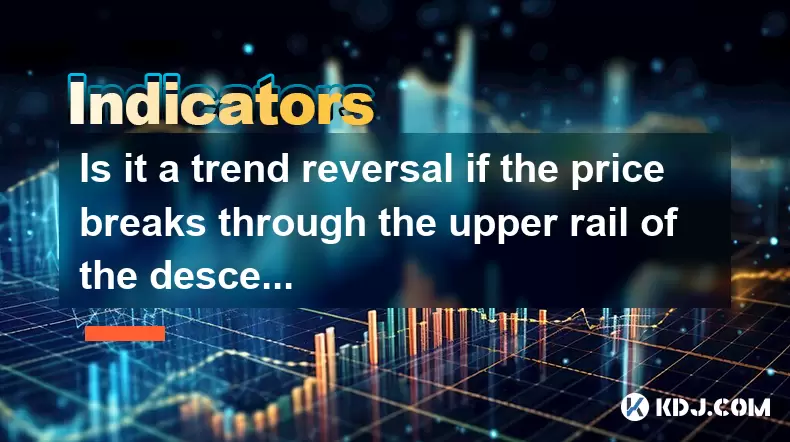
Is it a trend reversal if the price breaks through the upper rail of the descending channel and then steps back without breaking?
Jun 27,2025 at 05:35pm
Understanding the Descending Channel PatternA descending channel is a technical analysis pattern formed by two parallel downward-sloping trendlines, one acting as resistance and the other as support. This pattern typically indicates a continuation of a downtrend, where price action oscillates between these two boundaries. Traders often look for breakout...
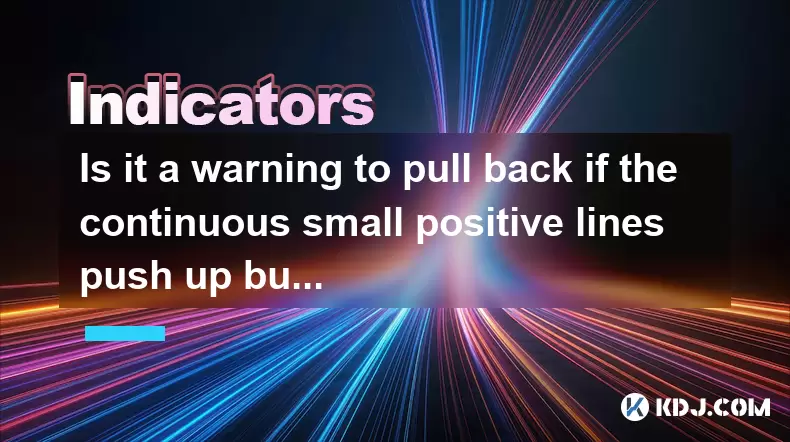
Is it a warning to pull back if the continuous small positive lines push up but the volume is insufficient?
Jun 27,2025 at 05:28pm
Understanding the Pattern: Continuous Small Positive LinesIn technical analysis, continuous small positive lines refer to a series of candlesticks where each candle closes slightly higher than its open. These candles usually have short wicks and indicate a gradual upward movement in price. Traders often interpret this pattern as a sign of steady buying ...

Is it necessary to clear the position when the 5-day moving average crosses the 10-day moving average?
Jun 27,2025 at 07:21pm
Understanding the 5-Day and 10-Day Moving AveragesIn the realm of technical analysis within the cryptocurrency market, moving averages play a crucial role in identifying trends and potential reversal points. The 5-day moving average (MA) and 10-day moving average are two of the most commonly used short-term indicators by traders. These tools smooth out ...

Can I add positions after breaking through the upper edge of the box and stepping back without breaking?
Jun 27,2025 at 09:56pm
Understanding the Box Breakout StrategyIn cryptocurrency trading, box breakout strategies are commonly used by technical analysts to identify potential price movements. A box, or a trading range, refers to a period where the price of an asset moves within two horizontal levels — the support (lower boundary) and resistance (upper boundary). When the pric...

Does the KDJ overbought zone blunting mean that the trend continues?
Jun 27,2025 at 03:35pm
Understanding the KDJ Indicator in Cryptocurrency TradingThe KDJ indicator, also known as the stochastic oscillator, is a popular technical analysis tool used by traders to identify overbought or oversold conditions in asset prices. In the cryptocurrency market, where volatility is high and trends can change rapidly, understanding how to interpret the K...

Does the appearance of a ground-volume cross star at the end of the decline stop the decline?
Jun 27,2025 at 10:35pm
Understanding the Ground-Volume Cross Star PatternIn technical analysis, candlestick patterns play a crucial role in identifying potential market reversals. One such pattern is the ground-volume cross star. This pattern typically appears at the bottom of a downtrend and is characterized by a small-bodied candle with long upper and lower shadows, accompa...

Is it a trend reversal if the price breaks through the upper rail of the descending channel and then steps back without breaking?
Jun 27,2025 at 05:35pm
Understanding the Descending Channel PatternA descending channel is a technical analysis pattern formed by two parallel downward-sloping trendlines, one acting as resistance and the other as support. This pattern typically indicates a continuation of a downtrend, where price action oscillates between these two boundaries. Traders often look for breakout...

Is it a warning to pull back if the continuous small positive lines push up but the volume is insufficient?
Jun 27,2025 at 05:28pm
Understanding the Pattern: Continuous Small Positive LinesIn technical analysis, continuous small positive lines refer to a series of candlesticks where each candle closes slightly higher than its open. These candles usually have short wicks and indicate a gradual upward movement in price. Traders often interpret this pattern as a sign of steady buying ...
See all articles























































































